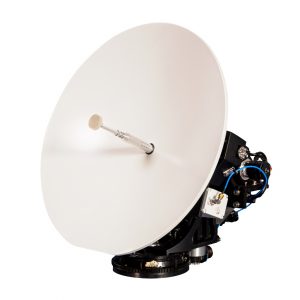
Orbit SATCOM Multi-Purpose Terminals win first major land contract, and look for others
Orbit Communication Systems, the Israeli company specialised on maritime and airborne SATCOM terminals, announced its first major order for land static and mobile use by the Israeli Ministry of Defence
No details were provided on which platforms will receive the company Multi-Purpose Terminals, MPT-30 and MPT-46 being those included in the contract, which is worth 9.1 million US dollars. Systems will be delivered during 2025. Based in Netanya, 30 km north of Tel Aviv, Orbit has a long experience in satellite communications, with over 4,000 of its systems installed on naval vessels, to which we must add those integrated onto aviation platforms. Now it is the turn of land to increase the number of SATCOM connected platforms.

“We acquired considerable experience in battlefield exercises worldwide, to which we must add lessons learned from the Russia-Ukraine conflict, and obviously from the ongoing war in southern and northern Israel,” Daniel Eshchar, Orbit CEO, told EDR On-Line. He considers that three main reasons are bringing land forces to increase the number of platforms equipped with SATCOM terminals, starting from key vehicles that are part of the C4I (Command, Control, Communication, Computer, Intelligence) chain, such as command and communications vehicles. “One of the main issues with line-of-sight (LOS) communications is jamming. It is easy to block communications when using VHF/UHF radios, jamming disrupting the C2 function,” he stated. “The second issue is that in a combat area crowded with many players, the RF spectrum becomes tight, interferences threatening good comms among vehicles, therefore more resilience is needed,” he added. SATCOM are inherently less subject to jamming, therefore having them as a backup solution allows to considerably increase resilience and lower the change to lose comms with the higher or lower echelon. “Not only SATCOM are more resistant to jamming, but our systems also allow customers to switch from one band to another and from one constellation to another, which makes them even more resilient.” Mr. Eshchar explained.
“SATCOM can become the main communications mean when operating in some specific scenarios, such as urban canyons or compartmented areas in the mountains, where terrain is hampering LOS communications,” the CEO said.

While SATCOM can guarantee the vital voice and data link between manned land stations and vehicles, ensuring command and control functions, another area is emerging. “Think about delivering a huge ammunition load in a dangerous area, this might be done without putting soldiers at risk using vehicles remotely controlled from a ground station linked via SATCOM with the platform,” Asaf Punis, VP North America Business Developmnent & Marketing underlined. “Currently we think about remotely controlled systems, but in a few years, we will have autonomous land vehicles, following what happened first in the sky and then on and under the sea,” he commented. Even when they will become autonomous, they will still need a link with their homebase, and SATCOM will be the solution as it will ensure BLOS link in all scenarios.
EDR On-Line understood the MPT terminals were designed for inception to be able to withstand the hard conditions in all three arenas, sea, air, and land. “We designed them to cope with Sea State 7 or 8 waves, which means high accelerations, and the need of a very accurate and responsive tracking system,” Daniel Eshchar pointed out. With the amount of experience acquired along the years, Orbit’s multipurpose terminals needed very limited adaptations to cope with land conditions. “We had to adjust the response of the electric motors, in order to increase accelerations on the various axis to respond to the movements induced by rough terrain, but this was done modifying the system’s characteristics working uniquely on software,” he said, as hardware was designed from the beginning to cope also with ground-based systems. Terminals installed on tracked or wheeled systems have some minor differences, due to adjustments made to take in count the different behaviours of the two types of platforms, EDR On-Line understood.

Compact, light and with a low power consumption, the MPT-30 and MPT-46, the number indicating the antenna diameter in centimetres, have respectively a mass of 10 and 12 kg, without radome and block upconverter (BUC), and operate in the Ku- and Ka-band, azimuth range being continuous over 360° while elevation range is 0° to 90°. Pointing accuracy is around 0.1° both static and on-the-move, signal tracking accuracy being better than 0.15dB RMS. The Effective Isotropic Radiated Power without radome, using a 50 W BUC, is 45.8 dBW in the KU-band and 52.0 dBW in the KA-band for the smaller dish, data for the 46 cm antenna being respectively 50.4 and 56.7 dBW. As for throughput, the two terminals can download data at a 126 Mbps and upload them at 29 Mbps. All Orbit systems are inherently cybersecure, according to the company.
Along the years Orbit developed simulators representing sea, air, and land conditions, on which its systems are tested in-house, off-road vibrations being simulated to verify systems compliance to MIL-STD and STANAG specifications.
The terminals can be provided in a ro-ro (roll-on, roll-off) configuration, allowing very quick and easy installation on any platform fitted for receiving the Orbit MPT. “If the cabling has been fitted into the vehicle, the terminal can be easily installed at base, as it is a matter of four bolts and two connectors, whole-in-whole a 20-minute business,” EDR On-Line was told.

While the national customer will soon start operating various platforms with Orbit SATCOM-on-the-move systems, Orbit is looking at the international market. “We will carry out eight demonstrations worldwide, the main areas of interest being Asia-Pacific and Europe,” the company CEO told us. EDR On-Line understood that Orbit already carried out a demonstration in Poland, which was attended by many NATO countries delegations, where MPT-equipped vehicles showed the system performance while driving on test tracks representing worst-case specs.
“We consider that the need for SATCOM terminals will increase within land forces, and while we are starting with key command and communication vehicles, in due time these will be installed also on lower echelon platforms as connectivity is becoming the key issue, and for this we propose our multi-band, multi-orbit, multi-platform solutions,” Daniel Eshchar concluded.
Photos and images courtesy Orbit



